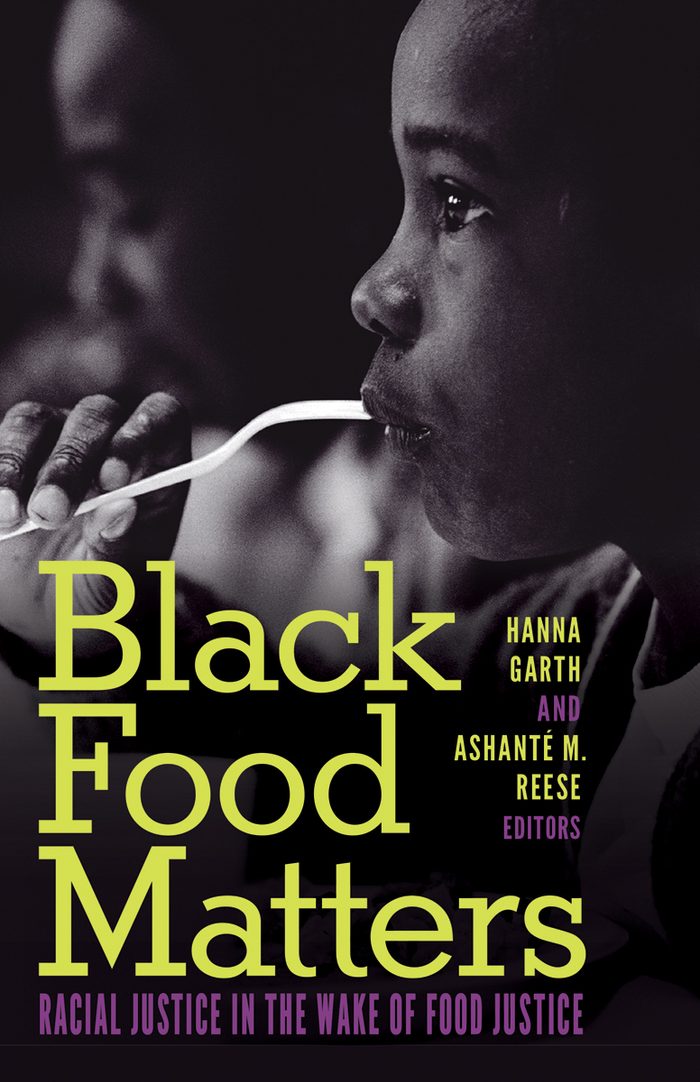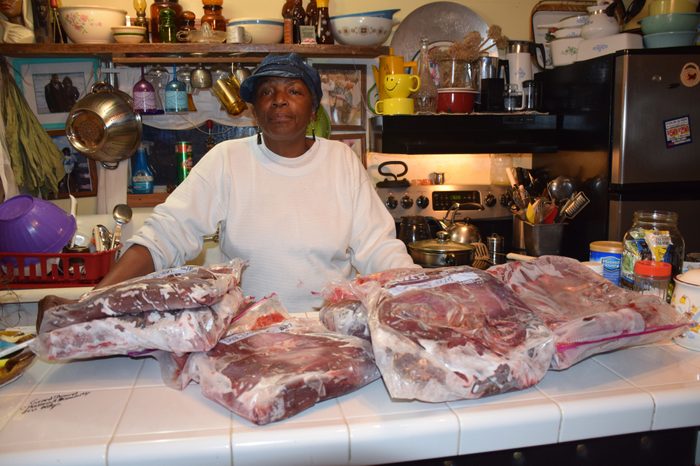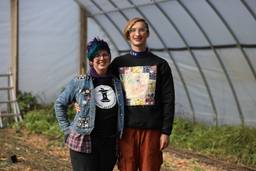Growing Food in Self-Defense
For years, Black folks in this small South Carolina town have tended gardens and raised animals to build personal resilience and protect their culture.
Gillian Richards-Greaves

Editor’s Note: In the following essay, the author embarks on a study of the Black food culture in the small South Carolina town of Cool Spring, to which she was introduced by a horticulturalist and former student named Glindian. The piece is excerpted from Gillian Richards-Greaves’s “The Intersection of Politics and Food Security in a South Carolina Town” in Black Food Matters: Racial Justice in the Wake of Food Justice, edited by Hanna Garth and Ashanté M. Reese. The excerpt is published with permission of the University of Minnesota Press. Copyright 2020 by the Regents of the University of Minnesota.
Although most of the Cool Spring population is employed outside the home, a sizeable portion of the community also practices horticulture, animal husbandry, fishing and foraging. When driving through the streets of Cool Spring, it is common to see neat rows of cabbage or other leafy vegetables, legumes, herbs, fruit trees and tubers such as potatoes. Coops, filled with chickens, ducks, and other domesticated birds, along with rabbits and pigs, are also a familiar sight. On the surface, Cool Spring seems like the average South Carolina town, where residents have resided for centuries on land that has been passed down from one generation to the next, but the narratives of this small community are much more complex and multilayered.

Cool Spring falls
within the geographic boundaries of the Gullah Geechee Cultural Heritage Corridor,
and many Black residents are descendants of Gullah Geechee people, who moved to
the mainland and maintained the horticultural practices of their foreparents as
a means of subsistence and economic advancement. The Gullah Geechee people live
along the coastal areas of Florida, Georgia, North Carolina, and South Carolina.
This community emerged during slavery in large part due to their relative
immunity to malaria and isolation from the mainland United States. These
enslaved Africans were captured from rice-growing regions on the continent of
Africa and transplanted to the southern United States. Their work on rice
plantations, which were infested with malaria-carrying mosquitoes, afforded
them relative autonomy, since enslavers often stayed away from the plantations
during the summer months, leaving Black overseers in charge of the enslaved,
who were immune to malaria. In this relatively autonomous environment, the
Gullah Geechee were able to maintain more of their African heritage,
particularly food values. It is in the Gullah Geechee community that many of
the southern cuisines categorized as “Black food” or “soul food” emerged and developed.
Cool Spring has always been a farming community where its members supplement their diet and income through local projects like foraging, farming, and animal husbandry. While residents from every ethnic group engage in similar subsistence strategies, this chapter focuses on the Black residents, for whom these practices constitute a preemptive strike against food insecurity. As Psyche Williams-Forson argues, “Food, including what it is, who prepares it, and sometimes how and when it is consumed, is intensely personal. Powerfully symbolic in its ability to communicate, food conveys messages about where we come from, who we are as individuals, and how we think and feel at any given moment.” For Black Cool Spring residents, food is not just a source of income and nourishment but also the preparation for a literal and figurative fight.
Very often, residents discuss the undercurrents of civil war that are currently raging, due to a country that is sharply divided along racial lines and rigidly entrenched in disparate political views. When political discord is underscored by racial strife, which it often is, it further validates the urgency for self-protection through food security and food sovereignty in the Black community. Thus, police shootings of unarmed Black people, the use of racial epithets by political leaders and other elected officials, and the proposals of bills and the passage of laws that seek to limit or eliminate subsidies (“entitlements”) cause dis-ease in the Black community and compel them to continue the struggle for self-protection.
Horticulture
In Cool Spring, food production and consumption continue to be the principal means by which Black residents articulate and maintain autonomy and tradition and safeguard against what they view as impending detrimental changes in the larger American society. I became interested in the role of food production, broadly speaking, within the Black community of Cool Spring after casual conversations with Glindian’s relatives, friends, and neighbors revealed the crucial yet multifaceted role that food played in the social structure and continuity of the community. For many, horticulture is their only source of income; thus, while they may share their harvest with relatives and neighbors, they also often sell their produce to earn a living wage.
Glindian has a large kitchen garden, the length of about half a city block, where she varies her crops seasonally. In the early spring, beginning in January, she plants white potatoes, garden peas, onions, broccoli, and spinach; in the late spring, she plants vegetables, including tomatoes, beans, and okra; and from late summer into early fall, she plants her winter garden, which includes broccoli, collards, mustard, turnips, and onions. Like many Cool Spring residents, Glindian also often gleans crops from her neighbors’ gardens when she needs specific crops, when she has not planted a specific crop for the season, or when her neighbors have excess produce. Cool Spring residents have an unspoken culture of crop sharing, but this is generally limited to relatives, close friends, and neighbors; thus, it would be frowned upon for non-residents or individuals who do not have a close relationship or established agreement to harvest crops from each other’s gardens.
Unlike Glindian, Tony, a law enforcement officer with a large extended family and deep roots in the community, tends his farm and raises animals in addition to his regular job. Tony has two gardens: a small one in his backyard as well as a larger one about the length of a city block across the street from his home. When I visited Tony’s garden in the fall of 2017, it had several vibrant rows of eggplant, cabbage, peppers, potatoes, and many other vegetables. What was striking to me was the fact that his garden across the street was not fenced in, which potentially gave anyone access to his crops. In fact, he informed me that neighbors and friends often harvested some of his crops, and he was fine with that, even though he planted them for his personal use. The day I visited Tony with Glindian, he gave us permission to harvest cabbage and other greens. Tony also raises pigs in his backyard, close to the smaller garden and a pond in which he keeps fish.
In addition to providing a financial support system for Cool Spring residents, farming has also become a means of diversifying their diet, allowing them to obtain a balanced diet year-round.
Because of the climate, the South has a relatively long growing period, and residents often produce more food than they can personally use, gift, or sell, forcing many to employ diverse preservation methods, such as canning, drying, fermenting, freezing, pickling, and smoking meats and vegetables for future use. For instance, a quick survey of Glindian’s home revealed mason jars of okras, peppers, greens, and even meats. When she has excess cabbage, collards, and other green leafy vegetables, Glindian blanches them, cools them, and stores them in freezer bags. Preserving foods in these manners ensures that she has greens for most of the year, even when she does not plant specific crops. Even though the South has a long history of preserving foods using these techniques, especially during national crises such as the Civil War, many Black Americans would have learned some of these preservation methods from their West African ancestors, who used them long before the advent of the Atlantic slave trade. During slavery, Blacks drew on their knowledge of preservation techniques to ensure they always had food, and after emancipation, they continued canning, pickling, and other forms of food preservation.
Procuring Meats
Cool Spring residents also supplement their diet by raising domestic animals, hunting game, fishing, and obtaining meat donations from neighbors and relatives. Glindian, for instance, raises ducks and chickens for meat and eggs. Additionally, from late fall through winter, when her white neighbors go hunting, they often bring her whole deer and other wild game, which she shares with relatives and friends. When Glindian kills chickens or receives donations of pork, deer, raccoons (“coons”), or other animals, she uses the meats to make soups, stews, and other cuisines. Recently, Glindian purchased a pig from one of her neighbors and named it Henrietta. After she slaughtered Henrietta, she made barbecued pork, sausages, hog-head cheese, and other delicious cuisines she shared with family and friends. Like Glindian, most residents eat diverse meats, but the slaughter and cooking of pigs seems to be an affair that brings together more members of the community to work and eat. It is not uncommon to see residents cooking (barbecuing) an entire pig while other members of the community eat, drink, and chat. In Real Pigs, Brad Weiss points out a similar phenomenon among white farmers in North Carolina, where pigs are a source of income, community building, education, and placemaking. As they do for to the residents of Cool Spring, pigs create that linkage between “cuisine and heritage” (Weiss 2016, 155), linking particular tastes to that geographic location and their heritage at large. Many residents preserve excess meats for later use by placing them into large storage bags, labeling them, and packing them in freezers according to their content. Some Cool Spring residents also dry and smoke meats to cure them. While Cool Spring residents may diversify their diet to accommodate visiting relatives, personal cravings, or an insufficient quantity of a specific kind of food item, the underlying influence continues to be an abundance of locally grown foods and relatively easy access to them.

More recently, my sons and I visited Glindian to help her harvest green onions, peas, and potatoes. On that same day, her uncle Sam, who lives across the street from her, was doing a whole-hog barbecue. We stopped by, engaged in humorous conversation, and even got our own to-go container of barbecue pulled pork. The meals that neighbors distribute help strengthen the community by providing sustenance for those in need, particularly the elderly, and giving others a reprise from cooking. As there is often an abundance of crops and meat, sharing meals with the community is also a means of combating waste that can result from having excess crops or meals.
Regardless of what is on the menu, however, members of the community, particularly the older ones, often provide commentary and feedback on the spices, preparation methods, and every aspect of the cuisines, as a way of simultaneously policing the boundaries of authenticity and articulating ethnic identity. In one of my numerous conversations with Glindian, for instance, she discussed the many methods of properly obtaining and cooking “coons.” Displaying a large freezer bag with a frozen raccoon, she explained: “If you don’t shoot your coon yourself, you never take a coon from anybody or purchase a coon from anybody without the feet being intact … because that way [without the feet] you can’t tell a coon from a dog. I mean, this could be any animal without a feet or tail or head.” Several other residents I spoke with discussed various cuisines and the lengths to which they go to ensure that it is “just like mama used to make it” or like an established standard. Thus, producing their own foods allows Black Cool Spring residents to maintain Black foodways by reducing or eliminating the scarcity that results from seasonal crops or insufficient finances and ensuring some degree of authenticity.
Gillian Richards-Greaves is associate professor of anthropology in the Department of Anthropology and Geography at Coastal Carolina University.




